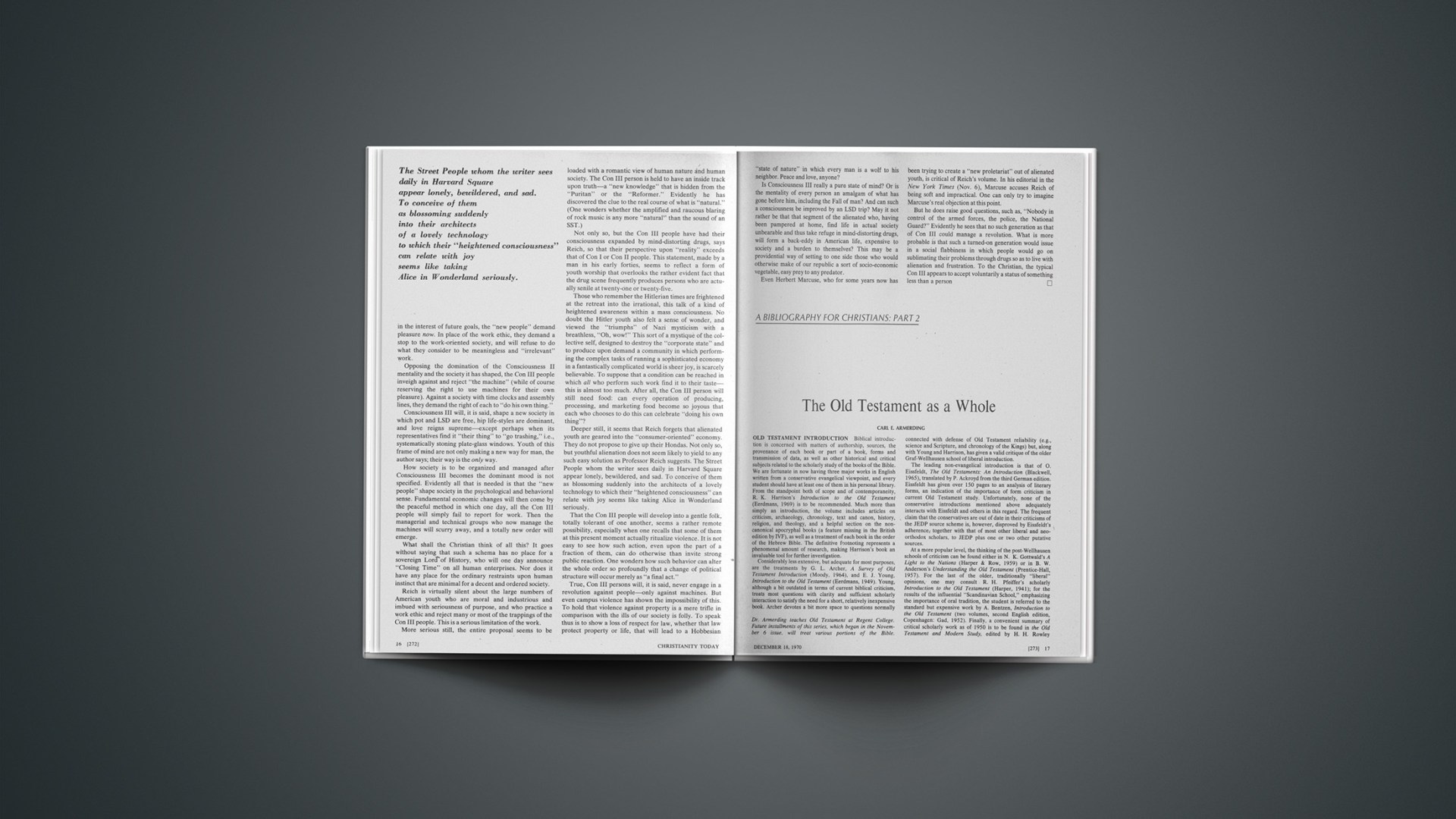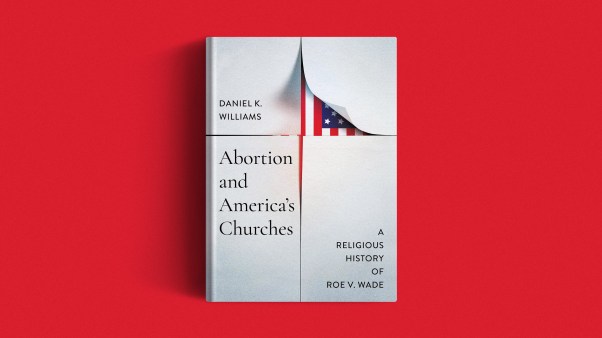Old Testament Introduction Biblical introduction is concerned with matters of authorship, sources, the provenance of each book or part of a book, forms and transmission of data, as well as other historical and critical subjects related to the scholarly study of the books of the Bible. We are fortunate in now having three major works in English written from a conservative evangelical viewpoint, and every student should have at least one of them in his personal library. From the standpoint both of scope and of contemporaneity, R. K. Harrison’s Introduction to the Old Testament (Eerdmans, 1969) is to be recommended. Much more than simply an introduction, the volume includes articles on criticism, archaeology, chronology, text and canon, history, religion, and theology, and a helpful section on the non-canonical apocryphal books (a feature missing in the British edition by IVF), as well as a treatment of each book in the order of the Hebrew Bible. The definitive footnoting represents a phenomenal amount of research, making Harrison’s book an invaluable tool for further investigation.
Considerably less extensive, but adequate for most purposes, are the treatments by G. L. Archer, A Survey of Old Testament Introduction (Moody, 1964), and E. J. Young, Introduction to the Old Testament (Eerdmans, 1949). Young, although a bit outdated in terms of current biblical criticism, treats most questions with clarity and sufficient scholarly interaction to satisfy the need for a short, relatively inexpensive book. Archer devotes a bit more space to questions normally connected with defense of Old Testament reliability (e.g., science and Scripture, and chronology of the Kings) but, along with Young and Harrison, has given a valid critique of the older Graf-Wellhausen school of liberal introduction.
The leading non-evangelical introduction is that of O. Eissfeldt, The Old Testaments: An Introduction (Blackwell, 1965), translated by P. Ackroyd from the third German edition. Eissfeldt has given over 150 pages to an analysis of literary forms, an indication of the importance of form criticism in current Old Testament study. Unfortunately, none of the conservative introductions mentioned above adequately interacts with Eissfeldt and others in this regard. The frequent claim that the conservatives are out of date in their criticisms of the JEDP source scheme is, however, disproved by Eissfeldt’s adherence, together with that of most other liberal and neo-orthodox scholars, to JEDP plus one or two other putative sources.
At a more popular level, the thinking of the post-Wellhausen schools of criticism can be found either in N. K. Gottwald’s A Light to the Nations (Harper & Row, 1959) or in B. W. Anderson’s Understanding the Old Testament (Prentice-Hall, 1957). For the last of the older, traditionally “liberal” opinions, one may consult R. H. Pfeiffer’s scholarly Introduction to the Old Testament (Harper, 1941); for the results of the influential “Scandinavian School,” emphasizing the importance of oral tradition, the student is referred to the standard but expensive work by A. Bentzen, Introduction to the Old Testament (two volumes, second English edition, Copenhagen: Gad, 1952). Finally, a convenient summary of critical scholarly work as of 1950 is to be found in the Old Testament and Modern Study, edited by H. H. Rowley (Clarendon, 1951), a collection of essays by members of the largely British Society for Old Testament Study.
WORD STUDIES The student, with or without Hebrew, will want to take advantage of the best word studies available. In a popular format, Edgar Jones’s small paperback The Greatest Old Testament Words (SCM Press, 1964) is almost too brief but may be used with profit if checked with a good concordance. Considerably more developed, but equally theological in scope (and now generally out of date), is the Theological Word Book of the Bible, edited by Alan Richardson (Macmillan, 1953). Both these volumes are written for the English reader and put all foreign words in transliteration. The English translations of a French Protestant work, published under the title Vocabulary of the Bible, edited by J. J. Von Allmen (Lutterworth, 1958), and a similar work by Roman Catholic scholars, Dictionary of Biblical Theology edited by X. Leon-DuFour (G. Chapman, 1967), will be found to be, in general, more helpful.
Equally useful for the student limited to English are the various word studies available in good Bible dictionaries, a source often overlooked but unmatched for accessibility. But, without a doubt, the real prize for the student who can read Greek and Hebrew is found in the Old Testament sections of the theological word studies edited by G. Kittel and G. Friedrich, Theological Dictionary of the New Testament (seven volumes, English translation by G. W. Bromiley, Eerdmans, 1964–). Despite the necessity of beginning with New Testament words and working backwards, and despite the great variation in quality from essay to essay, the wealth of material is such that he who ignores it does so to his own detriment. It is to be hoped that some future day will see the production of a similar effort devoted to Hebrew words in their own right.
CHRISTMAS: EVE AND MORN
The snow that falls this Christmas Eve
I hope may last the night;
The graves of those for whom I grieve
Need its enfolding white.
Tomorrow, Lord, on Christmas Day
Grant for my grief thy balms
Into my soul’s sad disarray
Breathe Thy commanding calm.
O Joy of Christ, on Christmas Day
Ring in my heart a chime;
Louder than grief, Lord, let it play
Healing the hurts of time.
As Christmas dawns, the snow lies deep;
It fell through all the night.
The graves of those for whom I weep
Shine in celestial light!
O Living Christ, this radiant mom
Be strong in me, I pray—
Stronger than death! For thou art born
To wipe all tears away.
In all who mourn, this Christmastide,
Fulfill thy promise true:
“Through change and sorrow I abide;
Lo, I make all things new.”
PAUL GERRARD JACKSON
HEBREW BIBLE Basic to any serious study of the Bible is the text itself, or the version chosen as representative of the original text. For students of Hebrew there are now alternatives to the old Biblia Hebraica, edited by R. Kittel. Presently available is the Old Testament in Hebrew (British and Foreign Bible Society, 1958), edited by N. H. Snaith. More significantly, under the editorial hands of K. Elliger and W. Rudolph the fascicles of the new Biblia Hebraica Stuttgartensia (Bibelanstalt, Stuttgart, 1968–) are appearing slowly but steadily, providing hope for a complete critical edition in the coming years. For regular Hebrew reading, however, we recommend purchase of some smaller edition that can easily be tucked in a suitcase or held in the hand (e.g. the Koren edition from Jerusalem).
Use of the critical apparatus of both Hebrew and Greek Bibles will be greatly aided by employment of a good introduction to each. For the older Kittel Bible, E. Wurthwein’s The Text of the Old Testament (Blackwell, 1957) is not only compact but indispensable, though the beginning student will find the small volume by D. R. Ap-Thomas, A Primer of Old Testament Text Criticism (1947), more readable. The Old Testament Text and Versions (University of Wales Press, 1951), by B. J. Roberts, covers a broader field than Würthwein and is a worthy companion volume.
HEBREW GRAMMAR Basic to any thorough study is a mastery of the Hebrew Bible. Beginners will find R. K. Harrison’s Teach Yourself Hebrew (Hodder and Stoughton, 1955) useful, especially if no teacher is available. Further help may be gleaned from A. B. Davidson and J. Mauchline, An Introductory Hebrew Grammar (T. and T. Clark, twenty-sixth edition, 1966); tapes for use concurrently are available from the Clark company (38 George St., Edinburgh, Scotland). The standard reference grammar in English is still A. E. Cowley’s translation and revision of E. Kautzsch’s twenty-eighth German edition of Gesenius’ Hebrew Grammar (Oxford, second edition, 1910). For historical grammar the older and incomplete Historische Grammatik der hebraischen Sprache des Alten Testaments, by H. Bauer and P. Leander (Halle: Niemeyer, 1922), may be consulted with profit. An expensive and somewhat loose collection of invaluable articles from a contemporary master may be found in A. Sperber’s A Historical Grammar of Biblical Hebrew (Brill, 1966).
Finally, the serious student should have several books on syntax (i.e., the relation of words to one another). Inexpensive and greatly varying outlines may be had from the pens of A. B. Davidson (T. and T. Clark, 1901), J. W. Watts (Eerdmans, 1964), and R. J. Williams (University of Toronto, 1967). The former is a bit dated, and the nomenclature and layout of the latter make it difficult to use. The work by Watts, though preoccupied with a particular theory (Driver’s on conjunctive waws), is clearly set forth and easy to use.
HEBREW VOCABULARY The treasures to be gleaned from effective word studies are among the richest within the Bible student’s reach. To exploit this wealth fully one must own a good Hebrew lexicon. Of course, if only a simple definition is required, a tool like the new Concise Hebrew Lexicon, by W. L. Holladay (Brill, 1970), or the Langenscheidt pocket dictionary of biblical Hebrew, is sufficient; but if the word is to be traced in its various shades and usages, something more definitive is required. That “something” is probably still best found in the old Hebrew and English Lexicon of the Old Testament, edited by F. Brown, S. R. Driver, and C. A. Briggs (Oxford, 1952), which doubles in most cases as a concordance. More recent work is represented in L. Koehler and W. Baumgartner’s Lexicon in Veteris Testimenti libros (Brill, 1953 with supplement 1958), in which the translations are given in both good German and bad English. Unlike the BDB volume, KB arranges words by alphabet rather than by root, a factor that might be worthwhile to the student who has forgotten how weak verbs really work.
For concordances to the Old Testament in Hebrew and Greek, see the earlier article in this series (November 6 issue).
GREEK OLD TESTAMENT A convenient and popular edition of the Septuagint (LXX) may be had in A. Rahlfs’s beautifully laid out Septuaginta (two volumes, Bibelanstalt, Stuttgart, 1949). The test is based on a reconstruction of the three great uncial manuscripts (Vaticanus, Sinaiticus, and Alexandrinus); therefore, careful use should be made of the textual apparatus in order to ascertain which manuscript of the LXX is being followed at any given time. H. B. Swete’s Introduction to the Old Testament in Greek (revised edition of 1914 reprint by Ktav, 1968) is very comprehensive, and S. Jellicoe’s recent monograph, The Septuagint and Modern Study (Oxford, 1968), brings Swete up to date. For a more elementary treatment, consult R. R. Ottley, A Handbook to the Septuagint (Methuen, 1920).
The serious Old Testament scholar will need to be at home in the Greek translation of the Old Testament. In this regard he will find A Grammar of the Old Testament in Greek (Volume 1, Cambridge University, 1909) by H. St. J. Thackeray an extremely helpful tool. The proposed volume on syntax was never published; however, the material on orthography, phonology, and morphology is excellent.
Lexical help for the Septuagint is not always available through New Testament lexica, but satisfaction will usually be gained by use of Liddell and Scott’s A Greek-English Lexicon (two volumes, Oxford, 1925–1940). Although this is primarily a classical dictionary, it often includes LXX usages. A lexicon to the LXX is being prepared by an international team of scholars, but completion will take many years.
OTHER LANGUAGES The serious Old Testament Scholar should also be familiar with the Ugaritic materials that have come to light during the present century. These are easily available to the pastor or student who reads Hebrew if he uses C. H. Gordon’s Ugaritic Textbook (Pontifical Biblical Institute, 1965), a model of clarity and organization. For Aramaic grammar, F. Rosenthal’s A Grammar of Biblical Aramaic provides the student with a good beginning point, though the more advanced student will want to make use of the Grammatik des Biblisch-Aramaischen (Halle: Niemeyer, 1927), by H. Bauer and P. Leander. For Akkadian (a term used to designate both Assyrian and Babylonian) there is presently no grammar in English, but the small Grammatik des Akkadischen by A. Ungnad and revised by L. Matous will be found helpful as a start. Arabic is a further cognate language of Hebrew, and for this the standard reference work continues to be the third edition of W. Wright’s A Grammar of the Arabic Language (Cambridge, 1896–98), a set the beginner will find impossible until he has mastered the elements of the language with the help of a volume like that of J. A. Haywood and H. M. Nahmad, A New Arabic Grammar (Harvard, 1962). Finally, there is Egyptian, and here nothing compares to the great volume produced by A. Gardiner, Egyptian Grammar (third edition, Oxford, 1957).
For Semitic cognate languages, there is also much lexical help available, though sometimes in expensive and highly technical form. The third volume of Gordon’s Ugaritic textbook is a glossary, with all words in transliteration and arranged in order of the Hebrew alphabet. Biblical Aramaic meanings will be found in the above-mentioned work by Rosenthal, but these are also available in supplements to the Hebrew lexica noted above. If one is close to a major Oriental library collection, definitive Akkadian lexical materials are now available in the multi-volume Chicago Assyrian Dictionary, steadily appearing under the editorial hand of A. L. Oppenheim (University of Chicago, 1956–). Among the various Arabic lexicons available, the best short treatment is still J. G. Hava’s Al-Faraid (Beirut: Catholic Press, 1964). The translation by J. M. Cowan of H. Wehr’s Dictionary of Modern Written Arabic (Cornell University, 1961) makes a real advance in clarity, but it does not cover classical forms in the manner of Hava.
A helpful corrective to any tendencies the student or scholar may have toward overworking the results of comparative linguistic study will be found in J. Barr’s latest volume, Comparative Philology and the Text of the Old Testament (Clarendon, 1968). Although Professor Barr does not sufficiently indicate the courses of action to be recommended, he does sound a necessary note of caution in a situation where the student with just a smattering of Semitic knowledge may easily be misled.
JOURNALS A valuable but often overlooked resource for any student near a major library is found in periodical articles. In addition to periodicals of general interest, mentioned in the earlier article in this series, there are important specialized journals in which the latest Old Testament and archaeological materials will be found. Perhaps the best technical Old Testament journal is the Zeitschrift für die alttestamentliche Wissenschaft, normally published semiannually, with articles in German, English, and French. A quarterly journal representing international scholarship is Vetus Testamentum, published in the Netherlands but with articles in the same three languages. For the latest archaeological results (in English), the Biblical Archaeologist and its slightly more technical sister publication, the Bulletin of the American Schools of Oriental Research, are available at nominal cost and would be a worthwhile investment for anyone wishing to keep abreast of the field. Doubleday Anchor Books has issued three paperback anthologies entitled the Biblical Archaeologist Reader I, II, III with the best of the articles from BA.
Also in English, and representing the best of Israel’s increasingly important archaeological contribution, is the Israel Exploration Journal. A similar journal representing British findings is the Palestine Exploration Quarterly. Two American journals devoted to the ancient Near East in a broader sense are the Journal of Near Eastern Studies, published by the University of Chicago, and the Journal of the American Oriental Society, a quarterly representing the best of that society’s research. One note in passing: if one will take the time required to look over the periodical list in his local or seminary library, and familiarize himself with the Reader’s Guide and the Subject Index to Periodicals (British) or the Index to Religious Periodical Literature, he will find that “keeping up,” even if only in one particular field, is not so impossible as it seemed. This is especially important in archaeology, a field where many a pastor and teacher blithely quotes outdated information, often to the discredit of his message.
SERIES A series may be catalogued in the periodical section of a library but is actually a collection of monographs or articles published annually or occasionally. Among the most important series for Old Testament students is the Hebrew Union College Annual, containing, in addition to biblical material, much Judaica and archaeological research. Readers should also be aware of the Studies in Biblical Theology, Old Testament Series, published in America by Allenson, a collection of moderately priced monographs without equal as reflectors of current scholarly concern.
Dr. Armerding teaches Old Testament at Regent College. Future installments of this series, which began in the November 6 issue, will treat various portions of the Bible.










